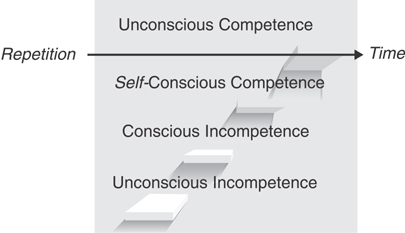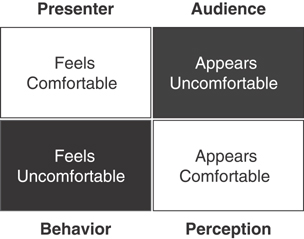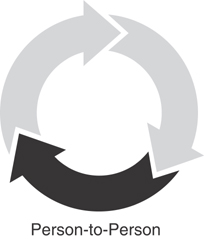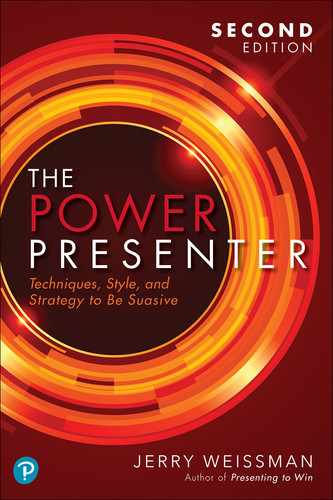Chapter Six
The Learning Process
Case Studies: Ken Kocienda, Apple • Joe Moglia, TD Ameritrade • Elon Musk, Tesla
The question has to be how to give instructions in such a way as to help the natural learning process of the student and not interfere with it.
The Inner Game of Tennis1
W. Timothy Gallwey
One of the most frequent assertions in the presentation trade is, “Good speakers are born, not made,” and its usual variation, “That person has natural charisma.” The corollary implication of this view is “Change is impossible” or “Nature nullifies Nurture.” For some unfathomable reason, many people cling to this mistaken preconception and recite it almost as a pledge of allegiance. The pledge persists despite overwhelming evidence and advice to the contrary from every walk of life: from the minor leagues to the majors, from Off-Broadway to Broadway, from ugly duckling to beautiful swan.
■ Change ■
Change is possible. It just takes time, skills, and effort.
■ The Four Stages of Learning ■
If you’ve ever taken up a new physical activity—a sport, dance, gymnastics, horseback riding—you’ve gone through a process known as the Four Stages of Learning (Figure 6.1). The same stages are also applicable to the physical aspect of presenting.

Figure 6.1 The Four Stages of Learning
Stage One
Unaware of what to do, you perform poorly and are unconscious about your incompetence.
Stage Two
The instructor tells you what you did wrong, and you become conscious about your incompetence.
Stage Three
The instructor tells you what to do correctly, and you become conscious about your competence. But the first time you try to follow the instructor’s advice, it feels unnatural. Stage Three, then, is being self-conscious about your competence.
The instructor then tells you to practice the new skill often. Repetition over time is central to learning any subject, any skill, be it mental or physical. If you practice often enough, you can get to…
Stage Four
You perform your skill without thinking about it, and you become unconscious about your competence.
Are you at Stage Four with your participatory sport of choice? Are you there with any sport? Have you ever been there? It is possible, but it cannot happen overnight. You cannot go from beginner to expert easily and quickly. You can improve only by going through all four stages. As a matter of fact, as you go through the stages, you will most likely spend the majority of your time at Stage Three, self-conscious competence. Undoubtedly, you will feel uncomfortable as you learn some of the new skills and exercises in this book.
The key for you to be able to make changes is to accept the discomfort of the learning process. Accept that you will have to step outside your comfort zone—which brings us to a paradox.
■ Comfort Zone Paradox ■
When you are up in front of an audience, and your adrenaline starts flowing, you feel the urge to fight or flee. What feels comfortable to you is to go into Body Wrap to protect yourself. Paradoxically, that behavior makes you appear uncomfortable to your audience. If, instead, you were to behave in a way that looks comfortable to your audience—opening your arms wide in welcome—you would feel exposed, open, vulnerable, and uncomfortable.
The paradox is expressed in the matrix in Figure 6.2, where the left side represents the presenter’s behavior and the right side the audience’s perception of the presenter.

Figure 6.2 The Comfort Zone Paradox
Taking a deeper look at the dynamics of Presenter Behavior/Audience Perception, let’s recall the table of negative behavior/negative perception from Chapter Three (Table 3.1), repeated here for your convenience in Table 6.1.
|
Factor |
Behavior |
Perception |
|
Eyes |
Scanning |
Furtive |
|
Features |
Immobile |
Disengaged |
|
Head |
Sweeping |
Impersonal |
|
Hands/Arms |
Body Wrap |
Protective |
|
Stance |
Off-Center |
Slack |
|
Volume |
Low |
Soft |
|
Inflection |
Narrow |
Monotonous |
|
Tempo |
Fast |
Harried |
|
Pattern |
Steady Stream |
Data Dump |
|
Unwords |
Multiple |
Uncertain |
Negative behavior, driven by the Yikes! moment and the instinctive Fight-or-Flight Reaction, creates negative perceptions in the audience. Once again, we have the same paradox: the very mechanism that enables us to survive in the wild makes us falter in captivity—as presenters.
How do we change the behavior to create a positive perception? How do we make each of these elements work for us rather than against us? The key is to approach the challenge from a 35,000-foot view and understand the paradox. If you accept that there is a difference between the way it feels to you as a presenter and the way it looks to your audience, please accept the fact that the skills you are about to learn and the exercise to practice them are going to make you feel uncomfortable.
When I coach participants through these same exercises, I ask them to stand in front of the room and gesture with their arms open wide. As soon as they do, I stop them and ask them how it feels. Invariably, they reply: “Overdone!” “Strange!” “Exaggerated!” “Inappropriate!”
Undoubtedly, you will feel the same when you try the instructions. Please reserve judgment about how it looks to your audience.
Before starting my own company, I worked as a hired hand for other training companies, teaching delivery skills. I spent the better part of my business days coaching participants to perform new behaviors. The new behaviors felt uncomfortable to them, and so they invariably resisted. Nevertheless, I continued to coax or cajole them until they performed the new behaviors. At the end of the day, they had changed, but only slightly.
At the same time, they felt substantially worse. As did I, for having inflicted such discomfort. The participants and I parted, each of us feeling unhappy and unfulfilled. As soon as I realized the paradox and started pointing out that the discomfort would diminish over time, my job got easier. The participants were free to continue their individual ascents toward Stage Four, at their own pace, in their own time. More importantly, they were able to make significant improvements.
One of them said to me, “The best tennis teacher I ever had didn’t expect me to get it right the first time!”
■ Repetition over Time ■
Repetition over time will flatten out the paradox. Eventually, opening your arms will feel comfortable to you and continue to look comfortable to your audience. You will look poised, confident, and ready to take on the world. Please keep in mind that it will take time for that to happen. You are not a race car; you cannot go from zero knowledge to zero defects in 60 seconds flat. You cannot go from white belt to black belt in a day. It takes time. Skiers must traverse the baby hills many times before they can move on to the advanced slopes.
Repetition over time reinforces habits. The behavior you have been practicing up to this point in your life is behavior you have been reinforcing. To develop new habits, you need repetition. The hurdles are high, with different heights for different human beings, but worth vaulting.
Repetition over time will move you from Stage Three to Stage Four, from self-conscious competence to unconscious competence.
Repetition over Time in Action
For a role model of practice, let’s return to Steve Jobs and his iPhone launch presentation. Having founded Apple Computer, then NeXT Computer, and then back to Apple again, he was quite comfortable making big pitches to massive audiences. Nonetheless, Jobs practiced that iPhone launch pitch extensively. Ken Kocienda, one of the engineers on the iPhone design team, described Jobs’ diligence:
Three weeks or a month before the keynote itself, Steve would start rehearsing portions of his slide deck in some venue at Apple…[and] ran through his entire presentation, from start to finish, twice each on the Saturday and Sunday preceding the keynote itself.2
Joe Moglia, chair of the board of TD Ameritrade, a financial services company, was the defensive coordinator for the Dartmouth College football team prior to entering the financial world. He also authored the book The Key to Winning Football: The Perimeter Attack Offense. When Joe was the CEO of TD Ameritrade, he engaged my services to help craft the company’s corporate presentation. During our sessions, Joe and I bonded as fellow coaches. He noted the similarities between learning presentation skills and his approach to football—and even to running a company:
Learning the new behavior requires going through discomfort. Because of the discomfort, people—and organizations—are resistant to change.
The key to effectuating change is to communicate to the individual—or the organization—that the discomfort is the price to pay to achieve the new results. If an athlete wants to excel, he or she will have to work out harder and longer. If an organization wants to improve its business, it will have to alter its tactics and perhaps even its structure. It will have to change.3
![]() (Video 24) Conversation with Elon Musk (Tesla Motors) —Web 2.0 Summit 08.
(Video 24) Conversation with Elon Musk (Tesla Motors) —Web 2.0 Summit 08.
https://youtu.be/gVwmNaPsxLc?t=92
Elon Musk, the founder and CEO of Tesla, launched his first electric vehicle, the Roadster, in 2008, and went on a promotion tour. One of his appearances was at the Web 2.0 Summit in San Francisco, where he touted the energy efficiency that electric vehicles have over fossil fuel cars:
Uh—so—the—the car is—it’s really—uh—so the elevator phrase is, “It’s faster than a Ferrari, more efficient than a Prius.” Ah—it’s—the zero to sixty time is 3.9 seconds—um—and we’re actually working on a power pack upgrade that’ll take that down to 3.6 to 3.7—uh—next year—uh—the energy efficiency—uh—in terms of miles per gallon equivalent—uh—is about 130—uh—so that’s—if you took a gallon of oil and you—uh—you refined it to gasoline and transported it to the gas station and—uh—and how many miles do you get in a car?4
Although Musk was obviously quite knowledgeable about his subject, his halting delivery, the frequency of Unwords, and his rapid pace made him appear uncertain and harried.
But he proceeded to make more and more presentations, culminating in his most important pitch of all, the Tesla Motors IPO roadshow in June 2010. On the first day of trading, the price of the company’s shares increased by 40.53% and closed at $23.89.5 As a public company, Tesla continued to lead the development, production, and proliferation of electric vehicles, and the hockey stick results continued their impressive ascent.
The success made Musk the darling of the speaking and media circuit. At a TED event, Curator Chris Anderson interviewed him about his favorite subject, energy efficiency. Anderson asked: “Most of American electricity comes from burning fossil fuels. How can an electric car that plugs into that electricity help?”6
![]() (Video 25) The mind behind Tesla, SpaceX, SolarCity… | Elon Musk.
(Video 25) The mind behind Tesla, SpaceX, SolarCity… | Elon Musk.
https://youtu.be/IgKWPdJWuBQ?t=56
Musk replied:
[Even] if you take the same source fuel and produce power at the power plant and use it to charge electric cars, you’re still better off. So, if you take, say, natural gas, which is the most prevalent hydrocarbon source fuel, if you burn that in a modern General Electric natural gas turbine, you’ll get about 60 percent efficiency. If you put that same fuel in an internal combustion engine car, you get about 20 percent efficiency. And the reason is, in the stationary power plant, you can afford to have something that weighs a lot more, is voluminous, and you can take the waste heat and run a steam turbine and generate a secondary power source. So, in effect, even after you’ve taken transmission loss into account and everything, even using the same source fuel, you’re at least twice as better off charging an electric car than burning it at the power plant.7
Exit the Unwords, enter a crisp, clear, and authoritative pace—the mark of a confident, assured, and knowledgeable leader.
■ The Yikes! Moment ■
Let’s flash forward to your next high-stakes presentation. The Yikes! moment has arrived. You hear the key decision maker in your audience say, “Okay, let’s get started.” Or you hear the preceding presenter introduce you. Or you hear your name boom out over the public address system, intoned by the disembodied voice of an announcer, known in the presentation trade as the “Voice of God.”
Now, however, having organized your content in advance and having Verbalized it to the point of familiarity, you step up to the front of the room with much greater ease of mind. You also throw that switch in your mind from “How am I doing?” to “How are you doing?” You focus on one specific “you” in your audience. You choose a woman in the middle of the back of the room.
However, that woman is not aware of your internal decision. Your job is to project your intent to her externally. The projection system to convey that mental decision is comprised of all the behavior items in the preceding Table 6.1.
You’ll note that the ten factors in the table divide into the two human dynamics with the most impact: the first five are the Visual, and the last five are the Vocal. The next three chapters will show you, with highly detailed, step-by-step instructions and exercises, how to master the best practices and create a new table with positive audience perceptions.
Of course, you cannot bring that table or this book up to the front of the room with you, or you will appear to be using a cheat sheet. Moreover, the list will be lengthy and would give you far too much to do—and not to do. You would have to ask yourself, “What did the book say I should do with my hands and arms?” “How should I stand?” “How should I make eye contact?” “How do I slow down?” “How do I keep from saying ‘Um’?” “Am I loud enough?” Before long, you would go into overload.
Instead, once the list of instructions is complete, I’ll compile all the granular details into three easy-to-remember Master Skills—and they will be all you’ll need from the Yikes! moment forward.
■ The Suasive Master Skills Cycle ■
You’re already familiar with the first of the three Master Skills: Person-to-Person Conversation. As you read in the previous chapter, this skill involves a shift outward from “How am I doing?” to “How are you doing?”
Person-to-Person Conversation is the first of three arcs, all linked in progression in Figure 6.3. Each skill leads to and powers the next in a virtuous circle.

Figure 6.3 First of Three Master Skills Cycle
The choice of Person-to-Person Conversations as the first of the Master Skills is intentional. A bit of perspective will illustrate why.
Earlier, I described my work as a hired hand for other presentation training firms offering delivery skills to businesspeople. All I ever offered, however, were instructions about body language and voice. I spent most of my days directing people just like you, ordinary mortals, to: “Do this!” “Don’t do that!” “Don’t do this!” “Do that!” “Do it bigger, smaller, faster, slower, louder, softer, wider, narrower…!”
These instructions were appropriate during my days at CBS, where I was directing announcers, reporters, newscasters, and program hosts, all of whom were professional performers. Businesspeople, however, are professional at their own job specialties, and when I treated them as performers, they balked.
“I’m not an actor!” “Hey, back off, Jerry!”
But I had a big bag of tips and tricks and, when I deployed them, I got my business clients to do exactly what I directed them to do: “Bigger, smaller, faster, slower, louder, softer, wider, narrower…” At the end of the day, I had them pounding the lectern and bellowing their words.
Unfortunately, when they went out into the real world and tried to present, they were so busy thinking about themselves and trying to remember all the many directions I had given them, they got all tied up in knots. Worse, they regressed to a point further back than where I had started with them.
When I started my own business, I realized that coaching delivery skills needed a different approach, to start with a familiar, natural base: Person-to-Person Conversations. Then, and only then, can we move on to the body language and voice skills, the other two arcs in our virtuous circle in the following chapters.
